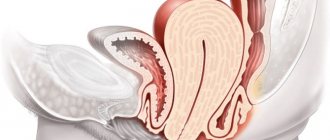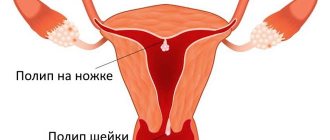How does uterine tone manifest during pregnancy?
The uterus is an organ that is hollow inside and outside consisting of several layers. The top outer layer (perimetry) is the mucous membrane, the middle layer (myometrium) is muscle, and the inner layer (endometrium) is another mucous membrane.
The uterus contracts precisely thanks to muscle tissue - the myometrium: this layer “organizes” contractions and “guides” the birth process, pushing the fetus out. Of course, throughout pregnancy the myometrium must be in a relaxed state so that the fetus develops calmly and comfortably inside the uterus - this state is usually called normal tone. If labor has not yet begun, but the uterus suddenly begins to contract, this condition is called increased tone or hypertonicity of the uterus during pregnancy.
This is not always a problem or danger, because the process of muscle contractions itself is physiologically normal, and many doctors consider periodic uterine contractions to be natural. Of course, this only happens if, in addition to the tone of the uterus, the pregnant woman does not have additional symptoms that signal serious problems. In fact, this attitude towards the problem of uterine hypertonicity is quite logical, since even when yawning or laughing, strong muscle contractions occur in a person, and the uterus also participates in them. Even stronger contractions of the uterus occur, for example, during orgasm or during psychological stress (during stress or a gynecological examination).
And yet, differences in the state of uterine tone exist, and they lie in the time of muscle tension. Short-term states of uterine tone during pregnancy do not cause problems and discomfort, but a long stay in hypertonicity can be not only painful, but also dangerous for both the fetus and the pregnancy.
What is uterine tone?
The uterus is a hollow muscular organ that has the shape of an inverted pear, located in the pelvic cavity in women. The uterus has 3 layers: external serous (perimetry), internal muscular (myometrium), internal mucous (endometrium). After conception occurs, the tone of the uterus is in a calm state - the muscle fibers grow and thicken, but do not tense and rarely contract. This is a prerequisite for the normal course of pregnancy. Myometrial tone is regulated by the pregnancy hormone progesterone. Myometrial tension in the form of regular contractions is observed during labor. The birth of a healthy child depends on the strength and duration of muscle contractions.
Under the influence of unfavorable factors of the external and internal environment, the normal tone of the uterus can change upward - hypertonicity. If the contractions of muscle fibers are short-term, of low intensity, and do not have a cyclical pattern, then such hypertonicity does not harm the intrauterine development of the fetus. With strong cramping contractions of the muscular layer of the uterus, which are accompanied by bloody discharge from the vagina or leakage of amniotic fluid, there is a threat of miscarriage or premature birth. Such hypertonicity is pathological and requires emergency medical care.
What is the danger?
The main danger is that the tone of the uterus during pregnancy in the early stages can lead to miscarriage, and in later stages - to premature birth. Uterine tone in the early stages of pregnancy (or rather, immediately after conception) occurs more often, because during this period the fertilized egg tries to attach to the uterine wall, as a result of which the muscles of the uterus tense. Excessive tension can reject the fertilized egg - for this reason, a miscarriage occurs.
Gynecologists often mention so-called “training contractions,” referring to the state of uterine hypertonicity on the eve of childbirth. Such “training” is not dangerous, since the uterus is simply preparing for the upcoming birth process.
But if there is still time before childbirth, then uterine hypertonicity is not just an uncomfortable condition, sometimes it is dangerous for the health and life of the fetus. For example, tension in the uterine muscles affects the umbilical cord vessels: when they are pinched under pressure from the muscles of the uterus, the child receives significantly less oxygen, and a state of hypoxia occurs. The child also begins to lack nutrients, and this threatens the occurrence of malnutrition - stopping the development and growth of the child.
Signs of tone
Only a gynecologist can accurately determine the tone. When the first symptoms of a threat appear, you need to visit a doctor to rule out dangerous consequences. What signs of uterine tone can be observed during pregnancy? The pathology is accompanied by:
- aching, squeezing pain in the lower abdomen;
- contractions of the uterine muscles;
- feeling of heaviness, discomfort;
- bloody discharge;
- tension, petrification of the abdomen;
- pain in the lumbar region, sacrum;
- feeling of contractions.
Why does hypertension occur?
The reason for uterine tone during pregnancy can be a variety of circumstances. It has already been said that even physiological reasons can tone the uterus. However, the causes of hypertension are most often problems and pathologies of pregnancy.
Here are the main ones:
- In the early stages of pregnancy, a situation may arise associated with a deficiency of progesterone, a hormone that the pregnant woman’s body produces the corpus luteum during the first four months after conception. The corpus luteum appears at the moment when the membrane (follicle) opens and the egg comes out. Progesterone is necessary to create conditions in the endometrium for the attachment of the fertilized egg to the wall of the uterus: with its help, the smooth muscles of the uterus relax, preventing it from becoming toned, and the fertilized egg is quietly implanted. With progesterone deficiency, severe tension occurs - hypertonicity, which interferes with the implantation process.
- An excess of male hormones in a pregnant woman’s body can also lead to a state of hypertonicity in the uterus. Therefore, the gynecologist always carefully monitors the hormonal levels of the expectant mother.
- If pregnancy is accompanied by symptoms of toxicosis (primarily frequent vomiting), then they cause the abdominal muscles to contract strongly, and the uterus is also influenced by this process. In the early stages, it is almost impossible to completely get rid of toxicosis, but it is necessary to at least partially relieve its symptoms in order to alleviate the condition of the pregnant woman and prevent uterine hypertonicity.
- With abnormal formation of the uterus (for example, a bicornuate, saddle-shaped uterus or other pathologies), a state of hypertonicity can also occur, and the risk of miscarriage seriously increases. It is advisable for a woman to learn about such pathologies not after conception, but much earlier. Knowing about the presence of these problems and devoting them to a gynecologist, a woman will be fully informed about how to behave and what to avoid in the early stages of pregnancy.
- Another reason for uterine tone during pregnancy may be Rh conflict. If a woman’s blood Rh factor is negative and her partner’s is positive, the pregnant woman’s body may regard the fetus as a foreign body. And in order to reject it, the tone of the uterus will increase.
- Inflammation and infection of the genital organs and uterus can also cause hypertension. In addition to the symptoms of hypertonicity, the pregnant woman will notice pain, itching in the perineum, and the pathological nature of the discharge.
- With multiple pregnancies or very large fetuses, as well as with polyhydramnios, the walls of the uterus can become very stretched - this can also cause hypertension.
- Also, the causes of uterine hypertonicity can be neoplasms and abortions, psychological stress and even problems with intestinal motility (in particular, increased gas formation) - all these negative aspects also affect the condition of the uterine muscles.
At the same time, it is important to understand that trying to independently diagnose yourself and determine the cause of uterine hypertonicity is not only a useless exercise, but also a waste of time, during which the doctor can conduct a professional diagnosis and do everything to relieve uterine hypertonicity and maintain pregnancy.
Causes of increased uterine tone
Hypertonicity of the uterus during pregnancy occurs against the background of the adverse effects of internal and external environmental factors.
- Structural anomalies and congenital malformations of the uterus, genital infantilism (underdevelopment of the genital organs).
- Hormonal disorders. Insufficient synthesis of the pregnancy hormone - progesterone. High levels of androgens (male hormones) in a woman’s body. Hyperprolactinemia (high concentration of the hormone prolactin).
- Chronic inflammatory diseases of the genital organs (endometritis, cervicitis, adnexitis).
- Sexual infections (chlamydia, ureaplasmosis, gonorrhea).
- Uterine neoplasms (fibroids, fibroids).
- Rhesus conflict. It develops when the woman has Rh-negative blood and the fetus has Rh-positive blood.
- Toxicosis in the 1st trimester of pregnancy, gestosis in the second half of gestation.
- Polyhydramnios, multiple pregnancies, large fetal weight.
- Exacerbation of chronic somatic diseases of the kidneys, liver, digestive tract, heart, lungs.
- Unfavorable obstetric history (medical and spontaneous abortions, frozen pregnancy, placenta previa, premature birth).
- The age of the pregnant woman is up to 18 years and after 35 years.
- Heavy physical activity, carrying heavy objects.
- Unstable emotional background, psychological trauma, chronic stress.
- A profession with harmful working conditions.
- Living in environmentally hazardous areas.
- Bad habits (drug, nicotine, alcohol addiction).
An increase in uterine tone can occur against the background of salty foods, spices, and herbal teas. To reduce the risk of hypertension, you should consult your doctor about which foods to exclude from your daily diet.
Symptoms of uterine hypertonicity
It is not difficult to independently understand that the uterus is in good shape. After all, the symptoms of uterine tone during pregnancy are so obvious and tangible that they cannot be confused with other manifestations.
So, during hypertension in the early stages of pregnancy, a woman feels a nagging pain (it can move to the sacrum or lower back) and an increase in heaviness in the lower abdomen. These sensations may resemble period pain.
In the second and third trimesters, the sensations will be similar, but additional ones will be added to them - compression and a state of hardening in the uterus and abdomen. In this case, spotting of a bloody-scarlet color may also appear. If you experience such symptoms suddenly, you should immediately consult a doctor, or better yet, call an ambulance. Before her arrival, try to get into a state of psychological balance, breathe, calm down. There is no need to panic ahead of time, since with early treatment, pregnancy can most often be saved.
Sometimes the uterus can become toned, but at the same time not “declare” this with any symptoms.
Norms of uterine tone by stage of pregnancy
In order for the baby to develop correctly in the womb, the uterus must be pliable and relaxed. Like any muscular organ, it has physiological contractions. What contractions of the uterine walls are considered normal? Experts highlight tone, which occurs in the early stages of pregnancy and is conditionally safe. In this case, uterine contraction:
- occurs no more than 6 times a day;
- promotes activation of blood circulation and normal development of the child;
- may be caused by mild physical exertion.
The following stages of pregnancy have their own characteristics:
- In the second trimester, starting from the 20th week, painless contractions are observed, which are considered training contractions, in preparation for future childbirth, and occur several times a day.
- With the beginning of the third trimester, the contractions of the uterus are helped by the baby, who begins to move actively. By the end of the term, hypertonicity is difficult to distinguish from the onset of labor.
How is uterine hypertonicity diagnosed?
To diagnose the uterus in a state of tone, the following is usually carried out:
- examination on a gynecological chair: as a rule, an experienced doctor will immediately notice this condition of the uterus;
- Ultrasound, which clearly shows not just the state of smooth muscles, but even the degree of pathology (first or second) and its location (on the anterior or posterior wall of the uterus); all this will help determine exactly where the uterus has changed its shape and where exactly the fertilized egg has attached;
- In addition, certain instruments are used to measure uterine tone, but their use is not particularly necessary, since diagnosing the tone is easy, but understanding the reason that led to it is much more difficult.
Diagnostics
To determine the tone of the uterus during pregnancy, ultrasound is most often used. On ultrasound, this pathology is very clearly visible - the walls of the uterus are clamped and compress the child.
Some doctors do not exclude the possibility that the tone of the uterus may be caused by the sensor of the ultrasound machine; nothing bothers the pregnant woman, but when she comes for an examination, the tone is detected. It is possible that the sensor “pressed” the walls of the uterus and they “shrank” in response.
Foreign ultrasound doctors say that at the beginning of the 1st trimester (when implantation of the embryo occurs) one cannot talk about any contractions. The fact is that when the embryo attaches to a certain area in the uterus, natural inflammation of this area occurs, which causes increased blood circulation in this place. All this is necessary for the embryo to take root, however, on ultrasound this area looks unusual and many ultrasound specialists get the impression of local tone.
However, with strong uterine tone during pregnancy, which is accompanied by constant painful tension in the abdomen, it is necessary to conduct an ultrasound examination of the cervix to prevent its shortening and dilatation.
If a throat opening of more than 5 mm is detected or the length of the cervix becomes less than 3 cm, then the risk of miscarriage or premature birth greatly increases.
A gynecologist can diagnose tone by palpation of the uterus, but most often this diagnosis is confirmed by an ultrasound report.
There is a special device for measuring the strength (degree) of uterine contraction - a tonusometer. In most cases, it is not used anywhere, because... its voltage is easily determined using the methods described above.
Is it possible to treat uterine tone during pregnancy?
So: the doctor told you that the uterus is in good shape. Do I need to do anything?
- First, listen carefully to the doctor’s recommendations: he will tell you in detail how serious your situation is, why it arose and what risks exist; if the risk is low, the doctor will prescribe outpatient treatment and will monitor your condition at each appointment.
- Secondly, even while at home, you will need to adhere to bed rest for some time and, most likely, take antispasmodics - papaverine or no-shpu. Perhaps, in addition to antispasmodics, magnesium B6 and motherwort will also be prescribed to relieve tone. These remedies will only help relieve symptoms (that is, the tone itself), and to treat its causes, the doctor will choose an individual regimen. For example, if the cause of hypertension is progesterone deficiency, then medications containing this hormone will be prescribed. If the level of male hormones is high, the pregnant woman will be prescribed antipodes. If there is a change in intestinal motility, medications that reduce gas formation will help, and if there is toxicosis, it will be necessary to take medications to relieve nausea. Also, individual treatment will be prescribed if a Rh conflict occurs (usually a gamma globulin vaccination is prescribed at 28 weeks of pregnancy and within 72 hours after birth).
- Thirdly, if the situation is serious and attempts to relieve uterine hypertonicity are unsuccessful, the doctor will most likely offer the pregnant woman hospitalization and observation in the hospital. Here a woman will be able to lead a more relaxed lifestyle (without being distracted by household chores, cleaning, etc.), and doctors will not only monitor her condition, but in the event of a critical situation they will quickly take action, relieve the sharply formed tone of the uterus and prevent premature birth.
- Fourthly, if the hypertension could not be relieved, and the pregnancy has already reached 28 weeks, then the woman will need to urgently prepare for childbirth. Despite the fact that the fetus will remain premature, it has every chance to survive and remain healthy - the state and technical capabilities of modern medicine allow this to be achieved.
- Fifth, if uterine hypertonicity provokes labor earlier than the 28th week of pregnancy, doctors will try to stop the labor process. For this purpose, tocolytic therapy can be used, which uses special agents and drugs that quickly relax the smooth muscles of the uterus. It is very important to carry out therapy in a timely manner to save the child’s life. And since bringing pregnancy to 28 weeks is a very important medical task, doctors are making every attempt to achieve this.
Treatment of hypertension
Outpatient treatment
Treatment of hypertonicity on an outpatient basis is possible only in cases where there is no direct threat to the life of the fetus, if there are no complications such as bleeding from the genital tract and fetal hypoxia, if the patient’s complaints are intermittent and do not cause the woman significant discomfort, if the woman is able to organize at home conditions for yourself, a gentle physical and emotional regime.
To eliminate hypertension in the first trimester of pregnancy, antispasmodics (Papaverine suppositories), sedatives (Valerian tablets, Motherwort tincture), and Magne-B6 preparations are prescribed.
Photo: https://pixabay.com/photos/medical-health-drug-tablets-1902006/
If the cause of hypertension is a hormonal disorder, gestagens (Duphaston, Utrozhestan) are indicated, the course of administration is determined by the doctor. If an infectious process is detected, antibacterial drugs are prescribed. In any case, when one or another cause of hypertonicity is identified, the doctor’s actions are aimed at combating the unfavorable factor that creates the preconditions for the occurrence of increased uterine tone.
In the second trimester, treatment is similar to the first trimester, but prevention of fetoplacental insufficiency (FPI) and fetal hypoxia (Curantil, Chofitol) is also indicated. In the third trimester, it is possible to prescribe tableted beta2-adrenergic agonists (Ginipral), and wearing a bandage is indicated. Therapy is prescribed to improve placental function (Hofitol)
The woman is shown peace in all respects. Both physically and psychologically, a pregnant woman must be balanced; sexual activity is excluded.
Hospital treatment
If uterine hypertonicity is intense and regular, accompanied by bloody discharge from the genital tract, if the fetus suffers (hypoxia is diagnosed), if a woman cannot organize a full protective regime for herself at home, if there is a direct threat of miscarriage or premature birth, then the woman should be hospitalized .
Therapy in a hospital in the first trimester of pregnancy consists of prescribing antispasmodics (Papaverine hydrochloride intramuscularly, Baralgin for severe pain), sedative therapy (Monwort tincture, Valerian tincture, Magne-B6).
In case of hormonal imbalance, synthetic hormonal drugs are prescribed (Utrozhestan, Duphaston, Progesterone for intramuscular administration, Menten, Pregnyl, Dexamethasone for hyperandrogenism). Bloody discharge is eliminated with hemostatic agents (Vikasol, Etamzilat). In order to correct the rheological properties of blood, Acetylsalicylic acid, Pentoxifylline, Dextran, and Heparins are often prescribed. Often, when organizing hematon after chorionic detachment, Wobenzym is indicated.
In the second trimester of pregnancy, surgical correction of ICI (isthmic-cervical insufficiency) is added according to indications. Anemia is treated if it is present (Ferretab, Ferrum Lek, Sorbifer). In order to improve the trophic function of the placenta and to prevent fetal hypoxia, Chofitol, Curantil, and vitamin complexes are prescribed. Magnesium sulfate is most often prescribed among antispasmodics.
Photo: https://pixabay.com/vectors/vitamins-tablets-pills-medicine-26622/
In the third trimester, you can add beta mimetics (Hexoprenaline, Ginipral, Verapamil along with tocolytics).
The expectant mother is given physical and psychological rest, consultation with a psychologist or psychotherapist.
Is it necessary to go to hospital?
The suggestion of hospitalization is often very upsetting for pregnant women, especially those who need to stay home for a second child or continue to go to work for an important project. In such situations, women often refuse to leave home for the hospital, promising the doctor not to overexert themselves, to take medications in a timely manner and, if anything happens, to call an ambulance.
Alas, it is impossible to predict the development of events in each specific situation, because in one case the risk of premature birth is indeed very high due to the high tone of the uterus, while in others it can be avoided. In any case, the decision will need to be made by the pregnant woman herself, because the doctor’s task is to inform her about possible risks and offer the possibility of hospitalization. It may be worth looking for a way out of the situation by asking, for example, for help from relatives or friends, and at work, for understanding from colleagues.
Treatment
Treatment of uterine tone during pregnancy is prescribed depending on the identified cause and the duration of pregnancy. In the first trimester of pregnancy, tone is usually associated with a lack of the hormone progesterone, so the woman must take a hormone test.
If the deficiency is confirmed, then synthetic analogues of progesterone Duphaston and Utrozhestan are prescribed. Utrozhestan can be used not only in tablets, but also in suppositories; in addition, it is made from plant materials, so many people prefer it. These drugs are prescribed until the 16-20th week of pregnancy and are gradually withdrawn. Such drugs cannot be abruptly discontinued due to the high risk of miscarriage.
For slight tone, use the well-known antispasmodics no-shpu, drotaverine, suppositories or papaverine injections. If they don’t help, they suggest going to a hospital for observation. The following drugs are usually used in the hospital:
- Magnesium sulfate or magnesium. It is used in the form of intravenous or intramuscular injections, with great caution in case of hypotension.
- Ginipral - in droppers or tablets and only after the 16th week of pregnancy. If ginipral is not suitable, use nifedipine.
These medications may cause an adverse reaction in the form of nausea, dizziness, vomiting, loss of strength, so such droppers should be placed under the supervision of specialists.
Important! In all cases, magnesium B6 is prescribed. Vitamin E (tocopherol) may also help, but is only prescribed in the first trimester.
In addition, some recommend drinking sedatives or teas with valerian and motherwort, but it is better not to experiment with herbs, but rather learn to relieve stress without drugs.
Regarding the bandage, it is better not to wear it. You can wear it when a pregnant woman cannot do without it.
Is it possible to cope with uterine tone during pregnancy on your own?
Sometimes you can relieve a slight tone of the uterus on your own, even without the use of medications. For this use:
- Certain exercises, one of which is “cat”. Get into the “table” position (on all fours with a straight back), now slightly raise your head and pelvis up, bending your lower back down. Take the reverse position: the head and tailbone move down, and the lower back moves up, gradually rounding. Repeat the exercise several times and then lie on your back in a relaxed position for at least an hour.
- Relaxing the facial muscles will also help to relax the smooth muscles of the uterus. To do this, do the following exercise: sitting or standing, start breathing through your mouth, lower your head to your stomach, relaxing the muscles of your neck and face as much as possible. Stand in this position for a while, trying to let go of all thoughts.
- The position of the “table” as a whole has a very beneficial effect on the condition of the uterus, and if you lower the upper body a little further, resting on your elbows, the uterus will be in a state of “suspense” and will relax even more. Therefore, if you feel the symptoms of hypertonicity, try to immediately take this position and stay in it until the situation stabilizes.
- If necessary, you can add antispasmodics and sedatives to the exercises, which your doctor will approve. If the state of hypertonicity continues to persist, you should not wait long, it is better to call an ambulance and accept the offer of hospitalization.
Causes
Why does the uterus become toned? Fear is one of the main factors that causes the uterus to contract. It has been noticed that women who are expecting their first child suffer the most from tone, and, as a rule, they constantly worry and worry about the future.
In addition, there are physiological reasons for tone:
- Lack of magnesium. The main signs of magnesium deficiency are muscle spasms, cramps and tone.
- Various pathological conditions during pregnancy: polyhydramnios, placenta previa, etc.
- Severe toxicosis, which leads to exhaustion of the body.
- If a woman is expecting twins or more children.
- If there is a history of female diseases - fibroids, adenomyosis, inflammatory (infectious) diseases of the appendages or uterus. All this affects the walls of the uterus, which can no longer fully stretch. Diseases of the appendages disrupt the hormonal balance in the body.
- Hormonal disorders - progesterone deficiency, which can occur due to excess production of androgens (male hormones) by the adrenal glands or ovaries. Another possible reason lies in the abundance of prolactin.
- Various genetic features of the uterus - infantilism and more.
- Physical tension, sexual arousal.
- A full bowel and bladder put pressure on the uterus and can cause contractions.
At risk are women with bad habits, who have “harmful” or physically difficult work, and also if they have had abortions in the past.
How to avoid hypertension
Of course, it is better to avoid uterine hypertonicity than to try to cope with it later.
Important preventive measures are:
- exclusion of serious physical activity and stress during pregnancy;
- maintaining a daily routine (sleep and rest) and a nutritious diet;
- eliminating bad habits (smoking and drinking alcohol), which not only can provoke uterine hypertonicity, but also increase the risks with additional pathologies;
- timely visit to a gynecologist, carrying out the necessary and recommended studies - especially if the pregnant woman is classified as a risk group.
Of course, in most cases, a pregnant woman manages to relieve the tone of the uterus, maintain pregnancy and minimize the possible consequences of this condition for the fetus. And yet it will be much safer to avoid such situations.
Prevention
Ideally, preventive measures should be taken to prevent such an unpleasant manifestation during pregnancy planning. It is important to undergo a full examination to determine whether a woman has infectious diseases or pathologies of the genitourinary system, visit an endocrinologist and pass all the necessary tests. If any pathology is detected, it must be treated before conception occurs.
When a woman becomes pregnant, a number of simple recommendations should be followed to prevent unpleasant manifestations.
- Eat properly and nutritiously, take vitamin and mineral complexes. Proper drinking regime is also important.
- Avoid excessive physical overload. If the expectant mother wishes to engage in physical exercise, then this can be done only after the approval of a doctor and under the strict supervision of specialists.
- Avoid stressful situations and excessive emotional stress.
- Try to minimize the use of gadgets.
- Minimize all phenomena that cause stress. For example, in the morning you should not jump out of bed; it is better to get up slowly and calmly.
The use of suppositories with papaverine
As one of the main drugs that can relax the smooth muscles of the uterus, doctors recommend using the antispasmodic papaverine hydrochloride. This drug is approved for use during pregnancy, so women often use it on their own.
Papaverine is available in various forms, but for pregnant women, it is usually recommended to use rectal suppositories: they do not have an adverse effect on the fetus, and in the event of a threat of miscarriage, they quickly reduce both increased blood flow in the placenta and uterine hypertonicity. Sometimes doctors prescribe intravenous injections of papaverine rather than suppositories, but only in a hospital setting and under supervision.
During pregnancy, many women often resort to papaverine. Some regularly use it to reduce uterine hypertonicity, while others use it quite rarely to reduce the effects of stress and fatigue (especially if a pregnant woman’s work involves standing on her feet for a long time). In such cases, papaverine quickly helps, relieving hypertension and eliminating possible risks.
To ensure the safety and effectiveness of the product, you must carefully study its instructions for use. It does not mention the negative effects of the drug on the body of the pregnant woman and the fetus. However, even so, you should not prescribe papaverine yourself; be sure to consult with your doctor about the possibility of its regular use.
The effect of papaverine hydrochloride on the body is antispasmodic, and the drug acts not only on the smooth muscles of the uterus, but also on the muscles of other organs of the respiratory, reproductive, urinary systems, as well as on the smooth muscles of the gastrointestinal tract. The drug is able to dilate smooth muscle vessels, helping to reduce blood pressure and stabilize blood flow. During pregnancy, papaverine is prescribed to relieve spasms from internal organs, as well as from peripheral and cerebral vessels, improve blood flow in the placenta and relieve uterine hypertonicity. You need to know that before using rectal suppositories, it is recommended to cleanse the intestines.
Before you start using papaverine during pregnancy, you should consult your doctor about the exact dosage of the drug. The usual dosage is to use suppositories 2 times a day, but in some cases this must be done 4 times at equal time intervals. Depending on the condition of the pregnant woman and the persistence of symptoms, the doctor will determine how long treatment should be continued: in one case, therapy can have an effect within a day, in another, treatment will last for a month or more.
The rectal suppository immediately enters the rectum and dissolves under the influence of body temperature. At the same time, the active substance is released from it, it penetrates the bloodstream, and through it it is delivered to all organs, simultaneously influencing the vascular system. Papaverine helps reduce the tone of the uterine muscles, relieve tension and pain, lowers blood pressure - in the later stages of pregnancy, many women need just such help.
It is prohibited to use the drug vaginally, so a pregnant woman must remember to use it exclusively rectally.
Why is uterine tone dangerous?
Uterine tone can be a physiological and pathological symptom. The danger is posed by hypertonicity of the organ, which negatively affects the health of the pregnant woman and the fetus. It is necessary to be able to distinguish which tone of the uterus bothers a woman. Treatment tactics and prognosis for pregnancy development depend on the condition of the myometrium.
Types of uterine tone.
- Conditionally safe tone. Appears throughout the entire period of gestation. Normal frequency is no more than 5-6 times a day. It does not cause intense pain, is not periodic (occurring at regular intervals), and is not accompanied by bleeding or leakage of amniotic fluid. In the 1st trimester, there is a feeling of heaviness in the stomach. In the 2nd and 3rd trimester, a woman can feel the tension of the uterus through the abdominal wall - the organ becomes “stony”. If there is already fetal movement, the baby’s movements usually intensify. Conditionally safe tone does not disrupt the normal development of pregnancy and represents irregular contractions of the myometrium under the influence of irritating factors of the internal and external environment.
- Uterine tone associated with training contractions. In the period from 24 to 30 weeks, training contractions occur, which prepare the woman and the unborn child for the process of labor. They are felt as weak, cramping pains in the lower abdomen and lumbar region, pass quickly and independently, and do not bring significant discomfort.
- Hypertonicity of the uterus with the threat of spontaneous abortion or premature birth. Prolonged, increasing cramping pain of high intensity in the lumbar region and lower abdomen that does not go away on its own. At the height of the pain syndrome, spotting or bleeding from the vagina, discharge of the mucous plug of the cervix, and leakage of amniotic fluid may appear. These are ominous signs that indicate in favor of termination of pregnancy.
Consequences of pathological tone of the uterus during gestation:
- disruption of blood flow in the vessels of the placenta, development of placental insufficiency, fetal hypoxia, intrauterine growth retardation;
- frozen pregnancy (intrauterine fetal death);
- premature placental abruption, massive uterine bleeding, threat to the woman’s life;
- threat of spontaneous abortion (up to 22 weeks of pregnancy);
- threat of premature birth (from 22 to 37 weeks of pregnancy).
If there is pathological tone of the uterus, you must immediately seek medical help in order to maintain pregnancy and normal intrauterine development of the fetus.
Contraindications to the use of papaverine
Despite the beneficial effects, contraindications and restrictions for use of papaverine still exist. For example, pregnant women with low blood pressure should not take it, since the drug has a pronounced hypotensive effect.
In what cases should papaverine hydrochloride not be taken during pregnancy?
- if a woman suffers from glaucoma;
- for tachycardia and heart rhythm disturbances;
- if there is atrioventricular block;
- with renal or liver failure;
- if you are allergic to any component of the drug;
- papaverine hydrochloride rectal suppositories should be used with caution in case of problems with the adrenal glands, dysfunction of the pituitary gland, or with a diagnosis of hypothyroidism;
- It is not recommended to use papaverine during breastfeeding, although there are no warnings about this in the instructions; if you still need to use a rectal suppository during lactation, it is better to stock up on a bank of breast milk in advance and interrupt breastfeeding for a while;
- and, of course, you should not use suppositories with papaverine too often: follow the doctor’s exact recommendations and dosage to avoid negative consequences.
- Expert
- Latest articles
- Feedback
About the expert: +MAMA
We are the friendliest site for moms and your babies. Questions and answers, unique articles from doctors and writers - we have it all 
- Headache during pregnancy - 12/19/2019
- How to lose weight after childbirth - 12/16/2019
- Second screening during pregnancy - 12/16/2019
- Precursors of labor in multiparous women - 12/13/2019
- How long do newborns sleep - 12/12/2019
- How to remove belly fat after childbirth - 12/12/2019
- Thrush in the mouth of a baby - 11/29/2019
- How to breathe correctly during labor and childbirth - 11/28/2019
- What to eat while breastfeeding - 11/26/2019
- How to wean a child from breastfeeding - 11/25/2019
See all
Signs and symptoms of uterine tone
The symptoms of this disease are clear even despite the fact that they differ depending on how far along the woman is. All symptoms can be divided into periods during which they occur.
If we characterize the symptoms that arise in the initial weeks of bearing a baby, they are characterized by:
- pain syndromes in the pelvic area;
- lingering pain is possible;
- pain can move to the lumbar region or to the sacral region.
Symptoms during the second and third trimester can be essentially similar to those that occur during the first weeks. You can independently visually identify this condition as the uterus becoming toned.
This appears as:
- abdominal compression;
- acute stomach;
- condensed condition of the uterus.
Any woman will understand and easily identify this condition. In exceptional situations, the disease may be characterized by bloody discharge. It is worth noting that the discharge is spotty in nature and is released in a small volume. In fact, such symptoms will become a cause for concern. In such cases, you should immediately call emergency medical help and first of all try to calm down. Often, if a woman consults a doctor about the problem in a timely manner, the pregnancy can still be saved. In some situations, this disease occurs without any symptoms and women do not feel the presence of uterine tone at all.
When is treatment required?
Short-term physiological contractions are harmless, but prolonged spasm leads to deterioration in fetal nutrition or provokes miscarriage. Treatment is necessary when:
- long-lasting pain in the lower abdomen, radiating to the sacrum or lumbar region;
- “contractions” (a condition when an organ intensively contracts and unclenches)
- bloody ones lived in the vaginal discharge;
- feeling that the uterus has become “stone”.
Severe pain, cramping pain or vaginal bleeding requires emergency hospitalization. The signs that arise indicate an incipient miscarriage or placental abruption. Medical care will help you maintain your pregnancy.
Features of the third trimester
Causes
Hypertonicity of the uterus can be provoked by:
- Excessive stretching of the uterus, if the fetus is very large or the woman is expecting twins.
- Polyhydramnios or oligohydramnios.
Symptoms
At the final stage of pregnancy, many women confuse training contractions with pathological uterine tone. Symptoms of suspected uterine hypertonicity are as follows:
- Specific pain, reminiscent of pain during menstruation, of a pulling nature.
- As in all previous stages of pregnancy, bloody discharge from the genitals should also force the pregnant woman to immediately contact a medical facility for help. In the later stages of pregnancy, such discharge may indicate the onset of placental abruption - a complication that can lead to the death of the baby and mother.
What does a toned uterus mean in pregnant women: prevention
This section has some recommendations for preventing hypertension during pregnancy:
- Calmness of the nervous system.
- Rejection of bad habits.
- Gentle work schedule.
- Healthy, full sleep.
- Compliance with diet and daily routine.
- Listen to relaxing music.
- Avoid contact with sick people.
These tips will help you avoid many health problems for the future baby and mother.
Hospitalization: yes or no?
What does increased uterine tone mean? You also learned how treatment is carried out in a hospital. Now let’s say a few words about whether it’s worth going to the hospital, or whether it’s better to choose treatment at home.
With hypertension, it is very important to maintain bed rest, which is almost impossible for a woman to do at home. After all, it is necessary to do the cleaning and prepare food, but it is not always possible to shift these responsibilities onto other shoulders.
If increased tone is detected at twenty-eight weeks or more, then hospitalization is important for the woman. Modern medicine is able to take out such a baby, he has a chance of survival. Before this date, the chances are extremely low. Therapy is aimed at stopping labor.
No one will send a woman to the hospital by force; the mother herself must understand that the life of the unborn baby depends on this. If the threat of miscarriage is high, then you should immediately go to a hospital for treatment.
How to relieve uterine tone at home?
It is quite possible to tone the uterus at home. However, in any situation it is necessary to inform your gynecologist about this.
To relieve the tone of the uterus, you will first need to create a favorable emotional environment, do not be nervous or worry. Then, it is necessary to spend most of the time in bed rest and not overwork. It is necessary to minimize all possible physical activity.
Ways to relieve uterine tone:
- Exercise cat.As you know, with the help of exercises you can also weaken and relieve the tone of the uterus. Exercise is one way to solve this problem. You need to kneel down and place your hands on the floor. Gradually you need to bend your back and carefully twist it in the opposite direction. All movements must be done smoothly and carefully so as not to harm the baby. It is also important to maintain even and calm breathing during the exercise.
- Relaxation is one of the ways to relieve uterine tone at home. An emotionally favorable environment and bed rest in general is the rest of the body, which allows a pregnant woman to relieve the tone of the uterus. It is advisable to adhere to this regimen for the remaining period of bearing the child.
- Warm shower. A warm shower can also have a beneficial effect and relieve spasms in the uterine area. As you know, a warm shower allows you to relax and, thanks to the temperature regime, restore the uterus to its previous state.
Prognosis and prevention
Throughout the entire period of pregnancy, a woman must be very attentive to herself, she must protect herself from stress, physical activity, at the same time have sufficient activity, take walks in the fresh air, get enough sleep, eat well and properly, and avoid bad habits.
A woman should have the right attitude and perceive her pregnancy as the norm, and not a pathology or disease. Regarding intimate relationships, if nothing bothers you, it is good and healthy to make love until the last trimester, however, if your stomach or lower back begins to hurt, or there is bleeding, “intimacy” should be postponed.
When can it develop
1st trimester
At this time, an increase in muscle tension indicates a possible termination of pregnancy. The occurrence of pathology is influenced by:
- sexual intercourse;
- physical exercise;
- stress;
- bowel movement disorders;
- toxicosis.
2nd trimester
In the second trimester, the pathological tension of the reproductive organ is more pronounced. Possible reasons:
- high water content;
- presence of twins;
- development of fibroids;
- endometriosis;
- blood rhesus discrepancy;
- pathologies of placenta position;
- inflammatory phenomena in the female genital organs.
3rd trimester
Before the 35th week of gestation, the appearance of muscle tension is undesirable. Causes of the pathological condition:
- pathologies of the child’s position;
- gestosis;
- placental insufficiency;
- history of cesarean section;
- possibility of miscarriage.
Uterus before birth
First, let's talk about why the uterus is in good shape before childbirth. What does this diagnosis mean immediately before the baby arrives? Let's start with the features of this stage:
- achieving maximum uterine size;
- with the correct presentation of the baby, the mother’s belly has the correct oval shape;
- just before childbirth, the stomach drops.
Is hypertension always observed before childbirth? It is worth remembering that immediately before contractions you can observe the uterus in good shape. What does it mean? Before childbirth, some changes occur in a woman’s body, and hypertonicity is a normal reaction of the body, indicating that labor has begun. During this period, the placenta and pituitary gland produce hormones that can strengthen the muscular structure of the uterus. This is necessary to prepare for the intense tension to expel the fetus. Hypertonicity in the forty-first week is quite normal, the body signals to us that labor has begun, and soon the mother will be able to hug her long-awaited baby.
Third trimester
What does increased uterine tone mean in the third trimester of pregnancy? These manifestations are already quite frequent and strong. This is due to the fact that the baby can provoke it himself, since he feels cramped in his mother’s stomach and rests against his legs and arms.
During this period, it is very difficult for doctors to diagnose hypertonicity, since these may be preparatory contractions. Of course, gynecologists play it safe by sending pregnant women for CTG procedures as often as possible.
It is also important to note that in Europe hypertonicity does not cause such a violent reaction among doctors. They believe that this is a normal condition for a pregnant woman. However, hospital treatment is prescribed for women for whom this symptom causes a lot of discomfort or there is a possibility of miscarriage.
As for domestic treatment, the recommendations are the same as in the second one. The following medications are prescribed to a pregnant woman:
- "Courantil";
- "Eufillin";
- "Trental."
They are necessary for hypertonicity, as they help normalize blood circulation in the uterus. As a result of treatment, the tone returns to normal, the baby receives the necessary amount of oxygen and nutrients.
Hypertonicity should not cause a mother to panic; it is a signal that she should pay more attention to her health. Also relevant drugs in this case are:
- lipoic acid;
- "Actovegin";
- "Riboxin";
- "Calcium pantothenate";
- "Essentiale";
- "Hofitol".
What does it mean if the uterus is in increased tone (hypertonicity)?
The symptomatic complex, when the uterine myometrium is compressed and tense, is called increased tone. Some clinicians (especially ultrasound specialists) define this condition as hypertonicity, but this term is not used in obstetrics. Uterine hypertonicity is talked about only in relation to labor.
If we talk about increased tension of the myometrium shortly before childbirth, for example, at 38 weeks, such uterine tone can be attributed to the so-called “training contractions”; these periodic muscle contractions are safe for the fetus.
When tension in the uterus increases at the wrong time - in the initial or middle period of pregnancy - and is characterized by increased intensity, this provokes a rise in pressure in the uterine cavity and threatens the course of gestation.
Uterine tone
How to determine it yourself?
The expectant mother is quite capable of independently determining the tone of the uterus if she is attentive to her well-being. Symptoms vary in degree of pathology and can manifest both in the 1st trimester and in subsequent ones.
What signs does it show?
Grade 1 uterine tone usually does not manifest itself as pathological signs, and the pregnant woman simply does not notice it. This condition is determined only by ultrasound, during which local thickening of the myometrium can be seen. Modern gynecologists generally tend to consider this situation normal, since:
- the zygote usually attaches to the posterior wall of the uterus;
- at the site of implantation a reaction occurs in the form of slight inflammation;
- this is accompanied by increased blood flow to the fertilized egg;
- because of this, the posterior wall of the uterus thickens, which is quite logical, but is often interpreted by ultrasound doctors as increased tone.
It is not uncommon for such a “diagnosis” (although it is just a symptom) to be made on the safe side.
In the 3rd trimester, symptoms such as heaviness in the sacral area or nagging pain in the lower back may occur, but they are quite tolerable. Despite the insignificance of the pain syndrome, a woman should still inform her doctor about these signs indicating the tone of the uterus and, possibly, develop a gentle regimen for bearing the baby.
Stage 2 uterine tone is more pronounced, symptoms of which occur in both the 1st and 2nd trimester. Here are some manifestations that will help you recognize grade 2 tone:
- pain below and noticeable tightening of the abdomen, palpable tension (“fossil”) in the muscle layer;
- spread of pain to the perineal area;
- a feeling of “fullness” in the external genitalia;
- spasm of the rectal muscles, urge to have a bowel movement;
- increased urination or the urge to urinate.
If a woman has previously suffered a trauma to the cervical canal, high tone is also manifested by contraction of the cervix, which cannot be determined independently, but is detected during an obstetric examination.
Symptoms by trimester
The symptoms of increased uterine tone do not correlate with the timing of pregnancy; its manifestations can appear both in the first months and in the second and third trimester. The intensity of the signs correlates with the degree of tone tension.
If you do not get rid of the increased tone at the beginning of gestation, by the 3rd trimester the symptoms often worsen: with grade 1, lumbar pain occurs, with grade 2, bloody discharge from the vagina, indicating an abnormal course of pregnancy and the danger of its failure.
The appearance of acute pain and traces of blood in the discharge, regardless of the duration of pregnancy, is a good reason for hospitalization of the expectant mother in hospital.
First trimester
Now we will talk about the dangers of hypertension in the first trimester of pregnancy. It is important to note that in the first weeks (from the fourth to the twelfth) the woman should not experience any discomfort. This is due to the fact that it is during this period that the probability of miscarriage is high. Ideally, the doctor will put forward the following verdict: uterine tone n. What does "n" mean? In medicine, this is customary to denote a good condition that is not in danger.
You should consult a doctor with any problem. If the situation is not serious, then you will be recommended to take a course of “No-shpa”. Hormonal problems can be solved by taking the drugs Duphaston and Utrozhestan. If other serious disorders are detected, then urgent hospitalization is necessary.
When you feel aching pain in the first trimester of pregnancy, you need to drink No-shpu and rest a little. Try to calm down, drive all negative thoughts away. If the pain does not go away, then call an ambulance. In the hospital, as a rule, injections of Progesterone are prescribed. For bleeding, use "Ditsinon", "Tranexam" and other hemostatic agents.
Ways to influence the condition
Determining hypertonicity is not difficult. The gynecologist determines it already during a medical examination. After 27 weeks, it is advisable to use CTG: this device records contractions of the fetal heart and movements of the uterine muscles.
Early dates
In the first trimester, it is advisable to use hormonal drugs (for example, Duphaston or Utrozhestan). Some patients are additionally prescribed:
- Drotaverine;
- Papaverine;
- Vikasol;
- Dicynone.
It is advisable to change your lifestyle with the exception of sexual intercourse.
Mid-gestation
In most cases, the use of Duphaston continues with a gradual reduction in dosage. Magnesium sulfate relaxes the muscles of the uterus, calms the nervous system, and improves the process of urine excretion.
Your doctor may prescribe Magne B6 to improve the functioning of the placenta. It is preferable to lie on your side or back.
From 7 months
During this period, the introduction of magnesium continues. Giprinal is indicated for some patients. Nifedipine is used to reduce tone. The tone is contained until the 3rd week of pregnancy.










